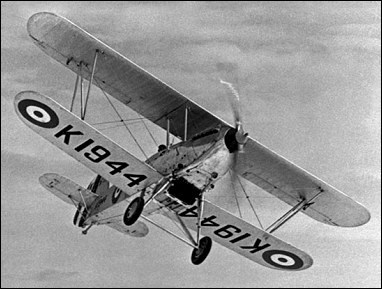 |
Hawker Fury1931 |  |
| FIGHTER | Virtual Aircraft Museum / United Kingdom / Hawker |
 |
Certainly the fastest and aesthetically one of the most elegant biplanes to enter service with the RAF, the Fury was evolved from an unnamed interceptor-fighter prototype which subsequently managed a level speed of more than 320km/h. Because the Air Ministry changed the official specification for a new fighter to include an inline rather than radial engine, Hawker developed the supercharged Rolls-Royce Kestrel F.XIS / D.XII S-engined Hornet. Later renamed Fury, it was evaluated against the beautiful Fairey Fantome (first flown on 16 January 1930). Emerging the winner, production of the Fury I began: the first 333km/h aircraft flying for the first time on 26 March 1931. Altogether 118 were completed for the RAF with 391kW Kestrel IIS engines. In addition, Hawker Fury number 401, powered by an Armstrong Siddeley Panther IIIA engine and flown on 5 August 1932, was exported to Norway, 16 Pratt & Whitney Hornet-powered Furies went to Persia, three Furies to Portugal and six Hispano-Suiza 12-engined aircraft to Yugoslavia. Fury Is first went to No 43 Squadron, RAF in mid-1931. Interestingly a Fury I won the coveted speed contest for military aircraft flying over a triangular course at the Zurich international meeting and in 1934 a number of RAF aircraft were sent to Canada to take part in the Centennial celebrations in Toronto. On 13 April 1932 the private-venture Intermediate Fury made its first flight, basically as a refined Fury I. After further modification it re-emerged with a 477kW Kestrel VI engine, with semi-evaporative cooling, flying for the first time in this form on 1 October 1933. With this engine it achieved a staggering 370km/h. British Aerospace records suggest that this biplane was re-engined in 1934 with a Goshawk III and flown on 17 October of that year, subsequently receiving a later Goshawk engine. More importantly on 3 May 1933 the experimental High Speed Fury flew for the first time. Initially it was powered by a Kestrel engine, with which it became the fastest of all Furies by attaining a speed of 394km/h; later it was fitted with a 518kW Goshawk. In 1934 it was decided that a Fury I should be fitted with a Kestrel VI with composite cooling, modified fuel and oil systems and streamlined wheel spats as the Fury II. This was first flown on 20 August 1935. Twenty-three production Fury IIs were built by Hawker with increased fuel capacity, followed by 89 from General Aircraft, six of which were delivered to the South African Air Force. Fury IIs entered RAF service in 1937 as an interim measure pending the delivery of greater numbers of monoplane fighters, remaining operational in their designed role until 1939. Exports were made to Yugoslavia, Persia, and Spain. When introduced into service Fury Is were the RAF's first fighters able to exceed 322km/h in level flight and gave good account of themselves during exercises. They were reliable, highly manoeuvrable and light on the controls and were most popular with their pilots. Fury IIs were even more impressive but were obsolete by the late 1930s and were retired not a moment too soon.
|  COMPANY PROFILE | |||||||||||||||||||||||||||||||||||||||||||||||||||||||
 |

|


